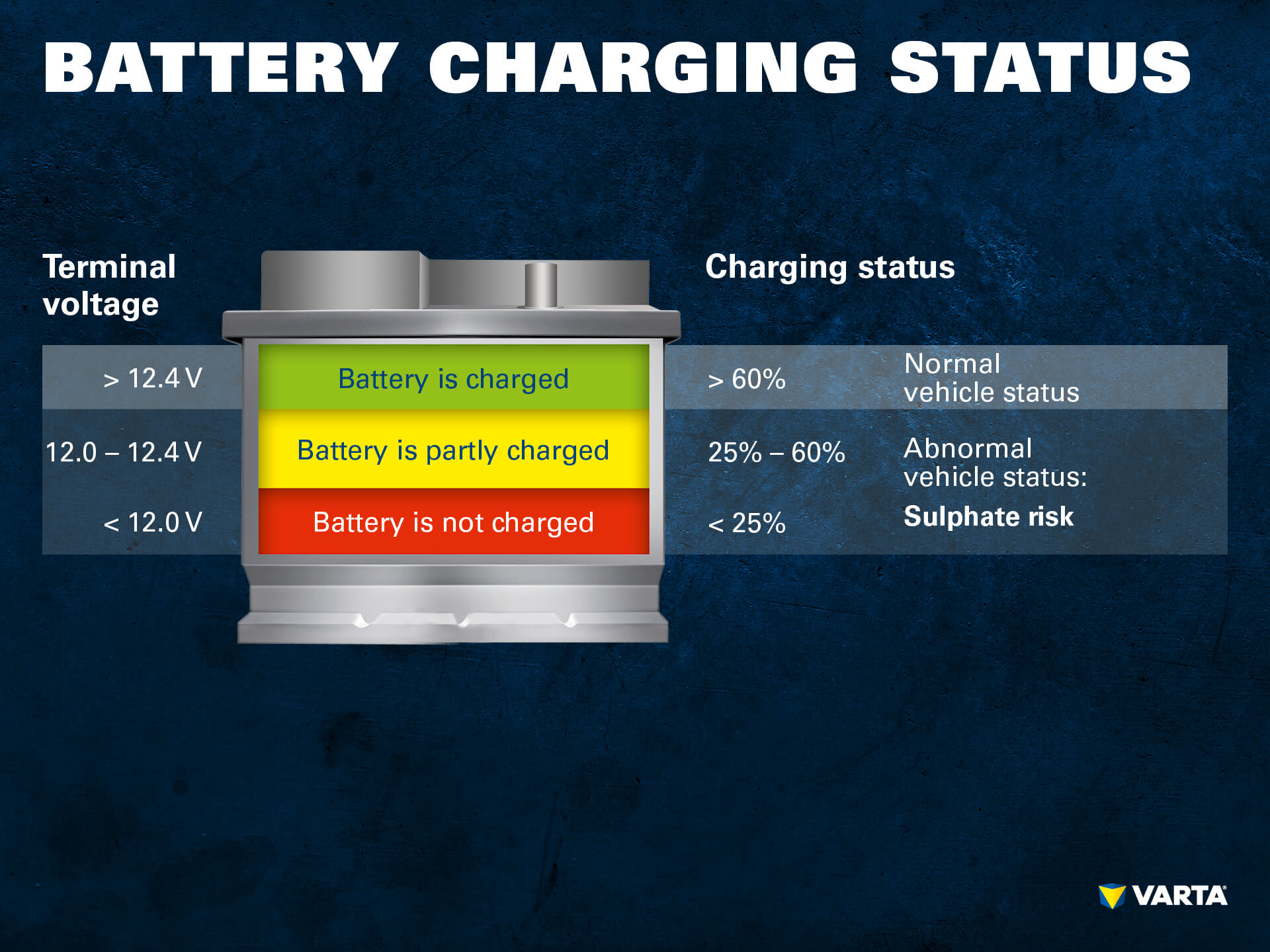How to Test a Stop Start Battery
To test a stop start battery, use a multimeter and measure the voltage between the positive and negative terminals. Ensure the battery reads at least 12.6 volts for accurate results.
A stop start battery is an essential component of modern vehicles, and it is important to ensure its proper functioning for smooth driving experience. To maintain a reliable stop start system, periodic testing of the battery is crucial. This testing procedure ensures that the battery is holding the required charge and functioning as designed.
By following a few simple steps, you can easily test a stop start battery to determine its overall health and performance. This comprehensive guide will provide you with the necessary information and steps to effectively test a stop start battery.

Credit: batteryworld.varta-automotive.com
Importance Of Testing Stop Start Batteries
Stop-start technology in vehicles has gained popularity due to its fuel efficiency and reduced emissions. In this blog post, we will discuss the importance of testing stop-start batteries to ensure optimal performance and reliability. By understanding how to identify stop-start systems and recognizing the need for testing, you can proactively maintain your vehicle’s battery health.
Identifying Stop Start System
Before diving into the testing process, it’s essential to identify whether your vehicle is equipped with a stop-start system. Stop-start systems automatically shut down the engine when the vehicle comes to a stop, such as at traffic lights or during prolonged idling. Instead of idling, the engine restarts quickly when you release the brake pedal or engage the clutch.
To determine if your vehicle has a stop-start system, look for indicators such as an “Auto Start-Stop” button or an “A” symbol on the dashboard. Additionally, check the owner’s manual or consult a professional technician for further confirmation.
Need For Testing Stop Start Battery
The stop-start battery plays a crucial role in the smooth operation of the system. Unlike a regular car battery, a stop-start battery is designed to handle the frequent engine restarts and extended periods of engine shutdown. However, over time, the battery’s performance can deteriorate due to various factors, including temperature changes and insufficient charging.
- Improved Fuel Efficiency: Testing a stop-start battery ensures that it can efficiently power the system and provide the necessary energy to restart the engine quickly. A weak or faulty battery might result in slower restarts, compromising the fuel efficiency advantage of the stop-start system.
- Preventing Premature Failure: Identifying any issues or weaknesses in the battery early on through testing allows for timely replacement or maintenance. This proactive approach can prevent unexpected battery failure and vehicle breakdowns.
- Maximizing Battery Life: Regular testing helps monitor the battery’s health and identify if it requires charging or replacement. By maintaining an optimal battery condition, you can extend its lifespan, saving you from unnecessary expenses.
- Ensuring System Reliability: A properly functioning stop-start battery ensures the reliability of the overall system. Testing the battery helps detect potential issues that could disrupt the smooth operation of the stop-start system, allowing for timely repairs or preventive measures.
Now that you understand the significance of testing stop-start batteries, let’s explore the different methods to test their health and performance.
Methods For Testing Stop Start Batteries
Stop-start systems in vehicles have become increasingly popular due to their ability to save fuel and reduce emissions. However, the proper functioning of the stop-start battery is crucial for the effective operation of these systems. To ensure the battery is in good condition, various testing methods can be utilized.
Voltage Testing
Voltage testing is a fundamental method to determine a stop-start battery’s health. Using a multimeter, measure the battery’s voltage while the vehicle is both running and turned off. A healthy 12V battery should display a voltage range between 12.4V to 12.7V when the car is not running. When the car is running, the voltage should exceed 13.6V, indicating that the charging system is functioning correctly.
Load Testing
Load testing involves simulating a high electrical load on the stop-start battery to assess its capability to provide power under stress. This can be accomplished using a specialized load tester. By applying a heavy load for a brief period, the technician can assess if the battery can maintain voltage within a specific range, typically 9.6V or higher, indicating its ability to handle the increased demands of the stop-start system.
Agm Battery Testing
AGM battery testing requires specific procedures due to the unique characteristics of Absorbent Glass Mat (AGM) batteries commonly used in stop-start systems. Conduct a thorough review of the manufacturer’s specifications and utilize an AGM-specific battery tester to ensure accurate readings and prevent damage to the battery.
Signs Of A Failing Stop Start Battery
One of the most common issues with modern vehicles equipped with stop-start technology is the failure of the stop-start battery. This battery, also known as an auxiliary battery, is responsible for powering the stop-start system, which automatically switches off the engine when the vehicle comes to a stop and restarts it when the accelerator is pressed. Recognizing the signs of a failing stop-start battery is crucial in preventing unexpected breakdowns and costly repairs. By understanding these signs, you can address the issue before it leads to more significant problems.
Dashboard Warnings
One of the primary indicators of a failing stop-start battery is the appearance of dashboard warning lights related to the battery or electrical system. These warning lights may include a battery symbol or an engine icon with the word “check.” If you notice any of these dashboard warnings illuminated, it is essential to have your battery and electrical system inspected promptly by a qualified technician. Ignoring these warnings can lead to more extensive and costly repairs down the line.
Engine Cranking Issues
When starting your vehicle, a failing stop-start battery may manifest as difficulty or delayed engine cranking. If you notice that the engine is slow to start or struggles to turn over, it could be a sign that the stop-start battery is losing its charge. In some cases, the engine may not start at all, indicating a more severe issue with the battery. Addressing these cranking issues early can help prevent the inconvenience of a vehicle that won’t start when you need it.

Credit: www.amazon.com
Steps To Properly Test A Stop Start Battery
Stop start technology has become increasingly popular in modern vehicles as a way to improve fuel efficiency and reduce emissions. However, one crucial component of these systems is the stop start battery. To ensure that the battery is in good working condition, it is essential to regularly test it. In this article, we will guide you through the steps to properly test a stop start battery, helping you identify any potential issues before they become a major problem.
Preparing The Vehicle
Before conducting the battery test, it is important to ensure that the vehicle is properly prepared. Follow these steps to get your vehicle ready for the test:
- Turn off all electrical components in the vehicle, including lights, air conditioning, and the radio.
- Park the vehicle in a safe and well-ventilated area.
- Engage the parking brake to ensure the vehicle remains stationary throughout the testing process.
Conducting The Test
Once the vehicle is prepared, you can proceed with conducting the stop start battery test. Follow these steps to ensure an accurate and reliable result:
- Put on safety gloves and goggles to protect yourself.
- Open the vehicle’s hood and locate the battery.
- Using a voltmeter, measure the voltage of the stop start battery. Make sure to connect the positive (red) lead to the positive terminal and the negative (black) lead to the negative terminal.
- Record the voltage reading displayed on the voltmeter.
- Start the vehicle and let it run for a few minutes.
- Measure the voltage again while the engine is running.
- Compare the second voltage reading with the initial one.
Interpreting The Results
Once you have conducted the stop start battery test, it is time to interpret the results. Here’s how to understand what the voltage readings mean:
| Voltage Reading | Interpretation |
|---|---|
| 12.6 volts or higher | The battery is in good condition and fully charged. |
| 12.45 volts to 12.6 volts | The battery is partially charged and may need a recharge. |
| Below 12.45 volts | The battery is discharged and should be recharged immediately. |
Understanding the voltage readings will help you determine the overall health and functionality of your stop start battery. If the results indicate a problem, it is recommended to consult a professional mechanic or replace the battery as necessary.
Frequency Of Testing Stop Start Batteries
Testing the stop start battery is crucial for ensuring its proper functioning. Regular testing helps in detecting any issues early on, preventing potential breakdowns.
Recommended Testing Intervals
1. Monthly basis: Ideal for frequent drivers or those who do a lot of short trips.
2. Every 3 months: Suitable for most average drivers to monitor the battery health.
Factors Influencing Testing Frequency
- Driving Habits: Urban driving may require more frequent testing.
- Vehicle Age: Older vehicles may need more frequent checks.
- Climate: Extreme temperatures can impact battery life.
- Battery History: Previous issues may warrant more frequent testing.
Stay proactive in testing your stop start battery to avoid unexpected troubles on the road.

Credit: batteryworld.varta-automotive.com
Frequently Asked Questions On How To Test A Stop Start Battery
How Do I Know If My Start-stop Battery Is Bad?
Signs of a bad start-stop battery include slow engine start, warning lights, and frequent jump-starts.
How Do You Test A Stop-start Car Battery?
To test a stop-start car battery, follow these steps: Turn off the engine and all electrical systems. Use a multimeter set to DC voltage to measure the battery’s voltage. If it falls below 12. 4 volts, it may need charging or replacing.
Alternatively, visit a professional mechanic for a battery load testing.
Can You Recharge A Start-stop Battery?
Yes, start-stop batteries can be recharged. It is essential to use a smart charger to properly recharge the start-stop battery. Regular maintenance and ensuring the charging system is functioning optimally can also help extend the battery’s lifespan.
What Is The Life Expectancy Of A Stop-start Battery?
Stop-start batteries typically have a life expectancy of around 4 to 5 years. Regular usage and proper maintenance can enhance their longevity. Good driving habits and the right type of battery can also contribute to a longer lifespan.
How Do I Know If My Stop Start Battery Needs Testing?
To check, monitor dashboard alerts and perform load testing for accurate diagnostics.
What Are The Signs Of A Failing Stop Start Battery?
Dim headlights, slow engine start, dashboard warnings, and overall decreased performance.
Can I Test A Stop Start Battery At Home?
Yes, use a multimeter or take it to a professional for a proper assessment.
Conclusion
In sum, testing a stop start battery is crucial to ensure its optimal functionality and longevity. By following simple steps such as checking voltage readings, inspecting physical condition, and assessing the overall performance, you can determine if your battery needs replacement or if there are any underlying issues.
Regular testing and maintenance will not only save you from unexpected breakdowns but also extend the lifespan of your battery. Don’t neglect this essential task and keep your stop start system running smoothly for years to come.

